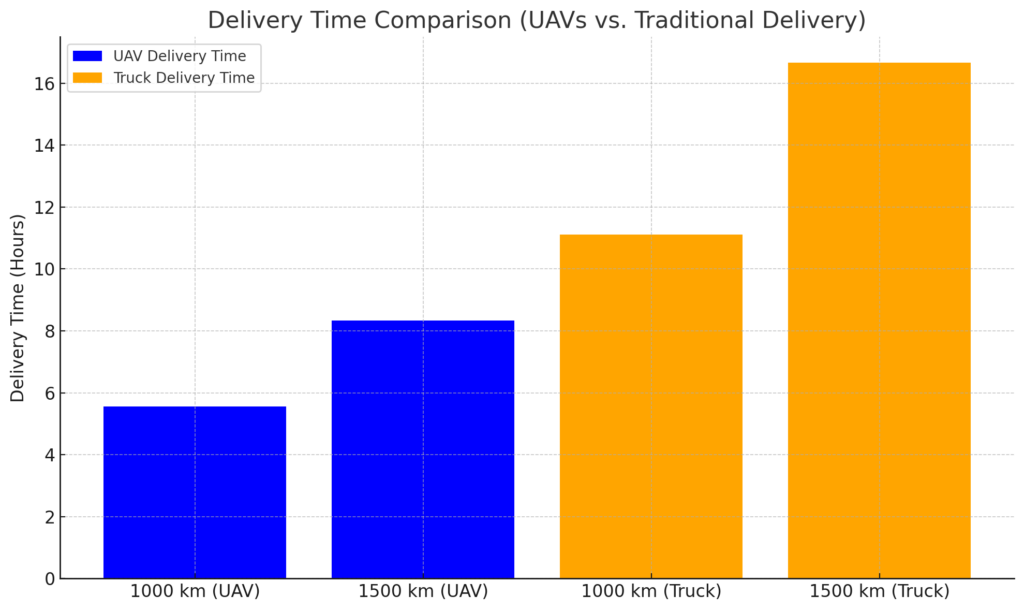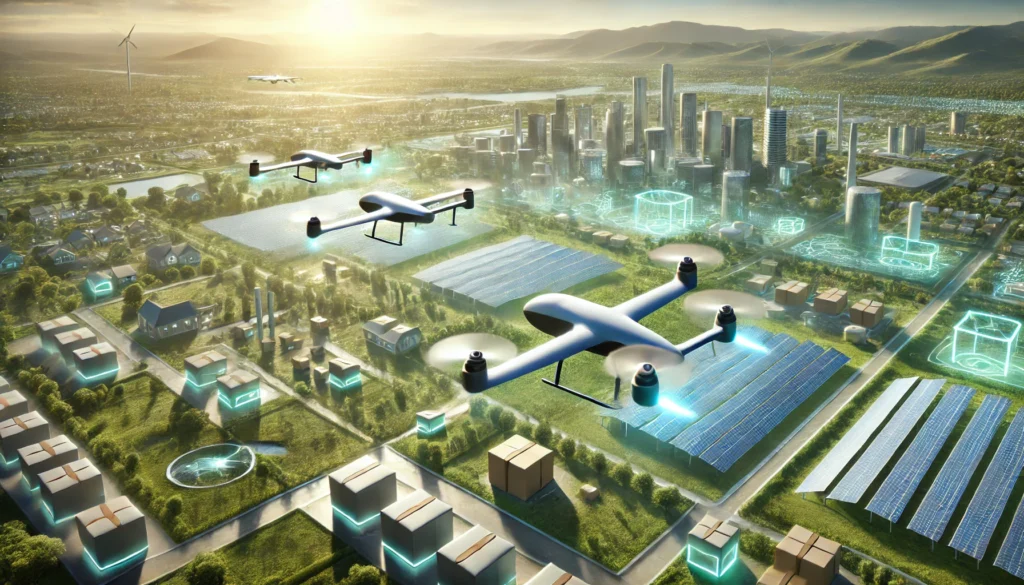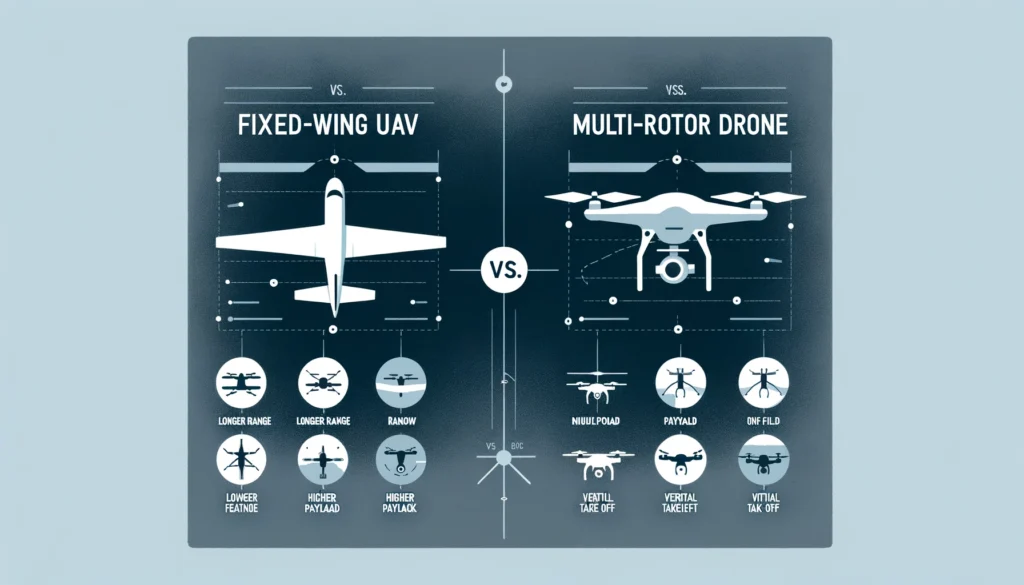Autonomous UAVs (Unmanned Aerial Vehicles) are revolutionizing the world of e-commerce logistics, offering faster, more sustainable, and highly reliable delivery solutions. As online shopping becomes increasingly popular, the demand for quick and efficient delivery services has grown exponentially. Autonomous UAVs have emerged as a game-changing technology, transforming last-mile delivery and ensuring goods reach consumers more efficiently than ever before.
How Autonomous UAVs Are Transforming E-commerce Logistics
Autonomous UAVs are helping e-commerce companies meet rising customer expectations by significantly reducing delivery times. They navigate directly from distribution centers to consumers, bypassing traffic congestion, poor infrastructure, and the need for intermediary stops. This ability to fly over obstacles provides unmatched efficiency and flexibility in delivery operations.

- Speed and Efficiency
Traditional delivery methods are often hindered by traffic, road conditions, and infrastructure challenges, which can cause delays. In contrast, UAVs can fly directly to their destination, dramatically reducing delivery times. For instance, a UAV flying at 180 km/h can deliver a package to a location 20 km away in under 7 minutes, allowing same-day or even same-hour deliveries.
Additionally, UAVs can follow optimized flight paths that minimize the time and distance traveled. This increased efficiency ensures that companies can fulfill more orders in less time, meeting the demands of a fast-paced e-commerce environment.
- Sustainability
Autonomous UAVs provide a more sustainable option for e-commerce deliveries compared to traditional delivery trucks. By avoiding road congestion and inefficient routes, UAVs contribute to reduced emissions and energy consumption in logistics operations. This is particularly relevant in densely populated urban areas, where traffic is a significant contributor to environmental pollution.
Moreover, UAVs can operate in remote or hard-to-reach areas where ground vehicles might struggle or require more fuel, making them ideal for reducing the overall environmental impact of deliveries in these regions.
Key Benefits of Autonomous UAVs for E-commerce
The integration of UAVs into e-commerce logistics offers several distinct advantages that make them an essential tool for improving delivery systems:
- Overcoming Last-Mile Delivery ChallengesLast-mile delivery, the final step in the delivery process, is often the most expensive and time-consuming part of the logistics chain. It accounts for a significant portion of total delivery costs, particularly in areas with heavy traffic or challenging terrain. UAVs are uniquely suited to tackle these challenges by bypassing traditional infrastructure altogether.
In rural or remote areas, where road networks may be underdeveloped or nonexistent, UAVs provide a reliable solution. They can reach consumers in regions that are difficult for traditional vehicles to access, ensuring that goods are delivered efficiently regardless of the location.
- Reduced Delivery Costs
By eliminating the need for drivers and reducing fuel consumption, UAVs have the potential to significantly lower delivery costs. The automation of flight paths allows UAVs to operate with minimal human intervention, reducing labor expenses. Additionally, fewer ground vehicles on the road mean less wear and tear on infrastructure and lower maintenance costs for companies.
For e-commerce businesses, these cost savings translate into higher profit margins and the ability to offer competitive shipping rates or even free delivery to customers, improving customer satisfaction and loyalty.
- Enhanced Delivery Reliability
Equipped with sophisticated navigation systems and real-time tracking, autonomous UAVs ensure that deliveries are made with a high degree of accuracy and reliability. Their ability to follow pre-programmed routes reduces the likelihood of delivery errors, and real-time GPS tracking allows both the company and the customer to monitor the delivery status.
This reliability is especially valuable in sectors that rely on time-sensitive deliveries, such as medical supplies, perishable goods, or urgent customer orders. By minimizing delays and errors, UAVs provide a consistent and dependable delivery service.
Environmental Impact of UAVs in E-commerce
With the rapid expansion of e-commerce, the environmental impact of traditional delivery methods is becoming increasingly problematic. Delivery trucks contribute to traffic congestion, air pollution, and noise in urban environments. Autonomous UAVs present a cleaner, quieter alternative for last-mile deliveries.
- Reducing Carbon Emissions
UAVs are designed to operate more efficiently than traditional delivery vehicles, helping to reduce the carbon footprint of e-commerce logistics. By avoiding traffic and taking the most direct routes to their destinations, UAVs use less energy than ground vehicles and contribute fewer emissions.
In addition to lower emissions, UAVs help reduce the number of delivery trucks on the road, which can significantly alleviate urban congestion and improve air quality in densely populated areas.
- Lower Environmental Footprint in Remote Areas
In areas where conventional delivery vehicles are inefficient or unavailable, UAVs can play a crucial role in minimizing environmental damage. UAVs can efficiently transport goods to isolated communities without the need for extensive road travel, reducing the overall environmental footprint of these deliveries.
Challenges to the Widespread Adoption of Autonomous UAVs
While the benefits of autonomous UAVs are clear, several challenges remain before they can be fully integrated into mainstream e-commerce logistics.
- Regulatory and Safety Concerns
The widespread use of UAVs for deliveries faces regulatory hurdles in many countries. Rules governing airspace, privacy, and safety are still evolving, and strict regulations often limit where and how UAVs can operate. Ensuring that UAVs do not pose risks to people, property, or other aircraft is a priority for regulators.
Governments and industries are working together to develop comprehensive frameworks that will allow for the safe integration of UAVs into commercial airspace. Until these regulations are standardized, the large-scale deployment of UAVs will remain limited.
- Infrastructure and Technology Development
The successful integration of UAVs into e-commerce delivery systems requires robust infrastructure. This includes dedicated drone ports, communication networks, and maintenance facilities that can support large fleets of UAVs. In addition, advancements in UAV technology, such as improved navigation systems, collision avoidance technology, and weather resistance, are critical to ensuring safe and efficient operation.
Investment in these areas will be necessary to support the scalability of UAV delivery services in the future.
The Future of Autonomous UAVs in E-commerce
The future of e-commerce delivery is undoubtedly tied to the development of autonomous UAV technology. As infrastructure improves and regulations evolve, UAVs will become an increasingly common sight in the skies, delivering packages quickly and efficiently to customers around the world.
- AI-Driven Innovations
The integration of artificial intelligence (AI) with UAVs will further enhance their capabilities. AI can help UAVs optimize routes, avoid obstacles, and adapt to changing weather conditions, ensuring that deliveries are made safely and on time. As AI continues to advance, UAVs will become even more autonomous, requiring less human intervention and improving overall efficiency. - Expanding Applications Beyond E-commerce
While e-commerce is currently one of the main sectors adopting UAV technology, the potential applications for UAVs extend far beyond online shopping. Sectors such as healthcare, agriculture, and disaster relief are exploring the use of UAVs for critical deliveries. In healthcare, for example, UAVs can transport medical supplies to remote or underserved areas, providing life-saving solutions in emergencies.
Conclusion
Autonomous UAVs represent the future of e-commerce logistics, offering a faster, more sustainable, and highly reliable alternative to traditional delivery methods. Their ability to overcome last-mile delivery challenges, reduce costs, and minimize environmental impact makes them an essential tool for the future of e-commerce. While challenges such as regulatory barriers and infrastructure limitations remain, the potential of UAVs to transform the delivery landscape is clear.
As UAV technology continues to evolve and regulatory frameworks adapt, we can expect to see these flying vehicles become an integral part of e-commerce logistics, reshaping the way goods are delivered to consumers.


